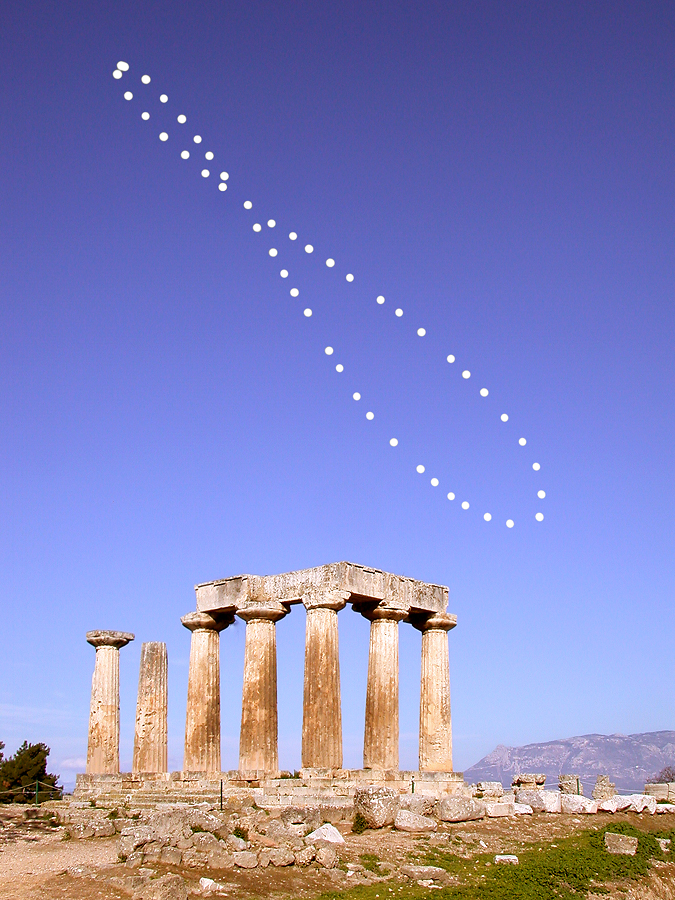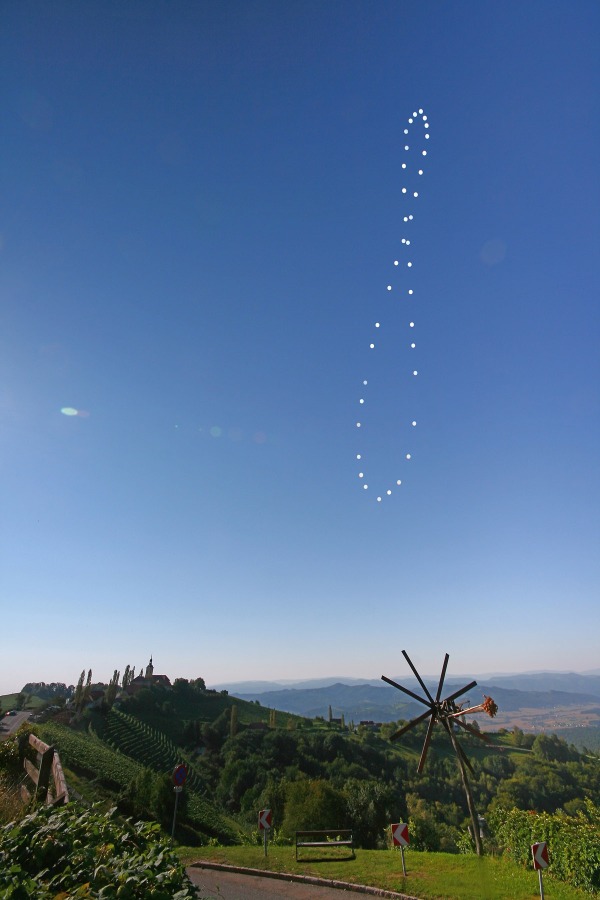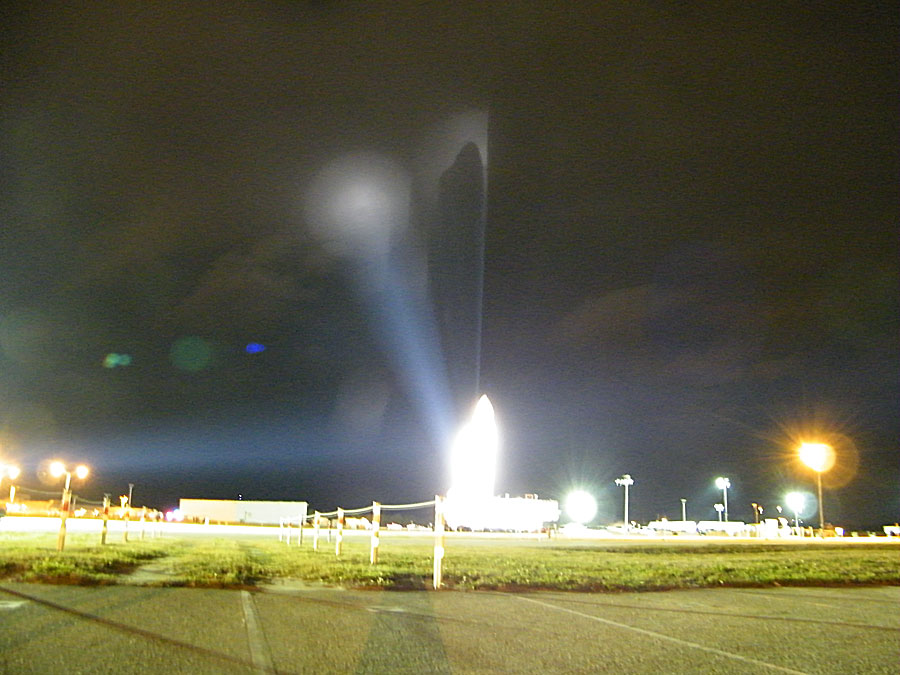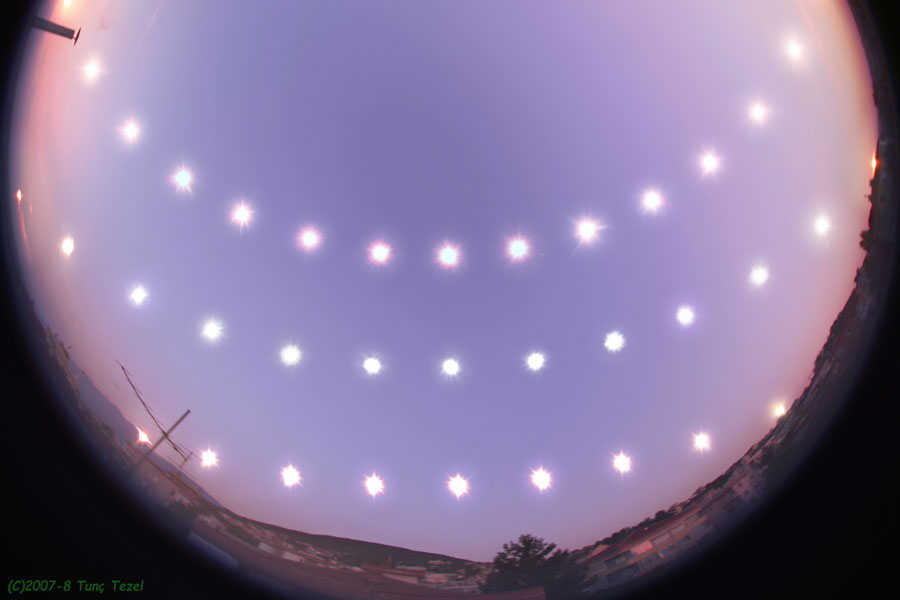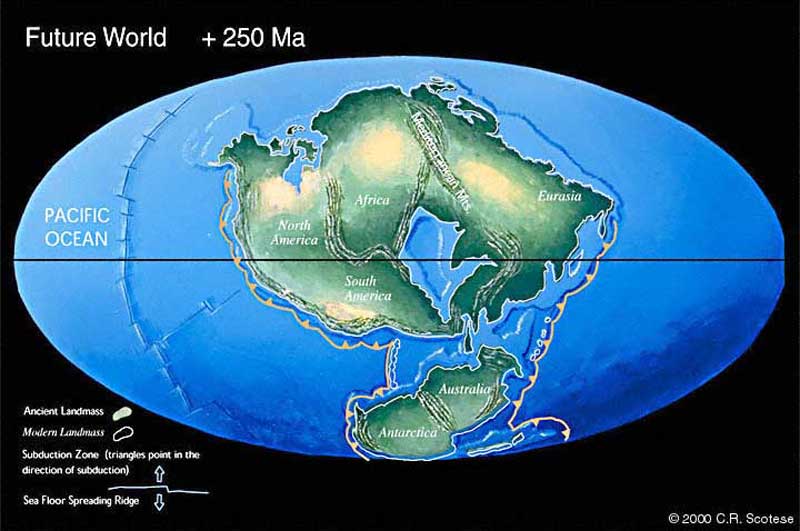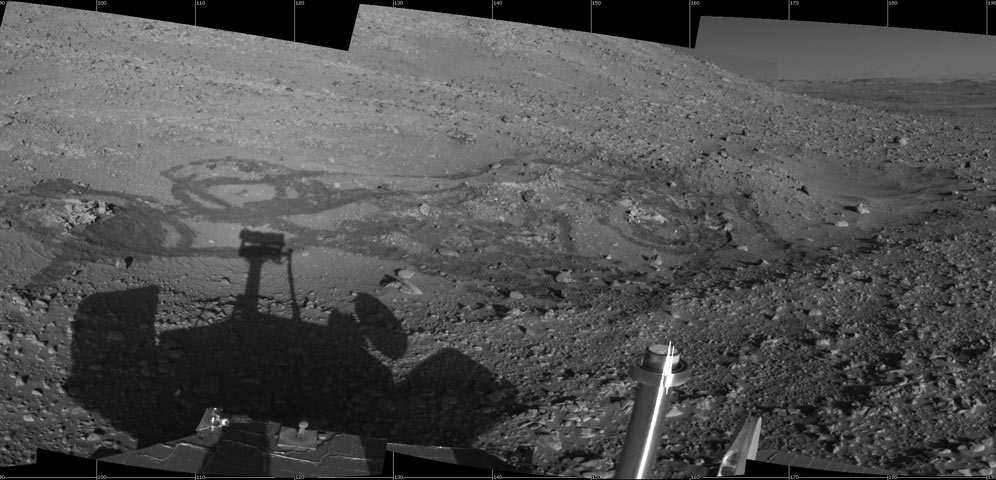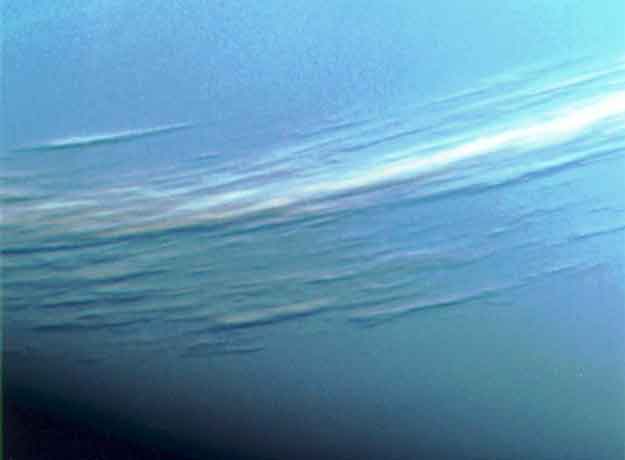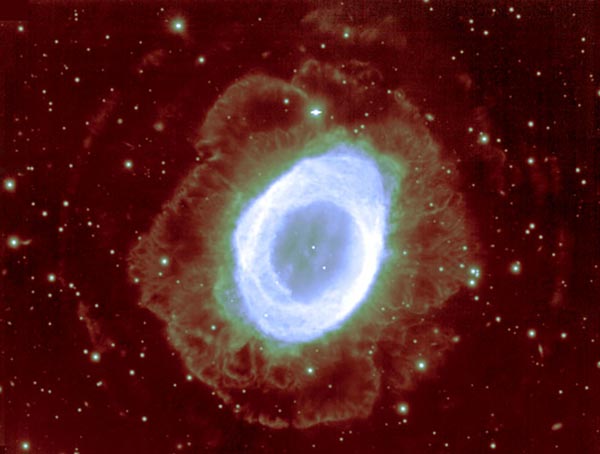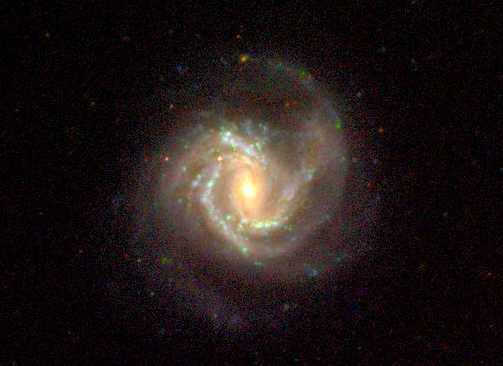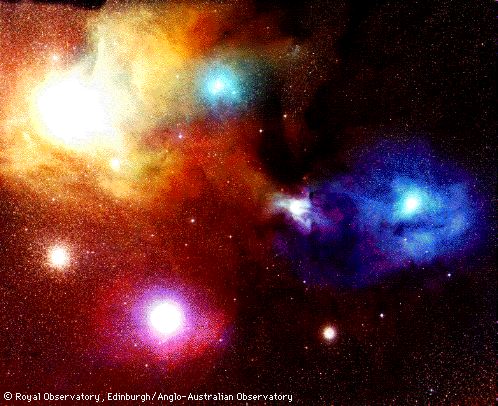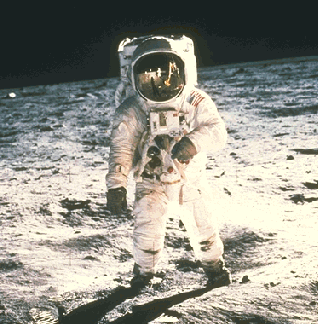| << Previous | Index | Next >> |
2015 What are those streaks of light in the sky? First and foremost, the arching structure is the central band of our Milky Way galaxy. Visible in this galactic band are millions of distant stars mixed with numerous lanes of dark dust. Harder to discern is a nearly vertical beam of light rising from the horizon, just to the right of the image center. This beam is zodiacal light, sunlight scattered by dust in our Solar System that may be surprisingly prominent just after sunset or just before sunrise. In the foreground are several telescopes of the Bosque Alegre Astrophysical Station of the National University of Cordoba in Argentina. The station schedules weekend tours and conducts research into the nature of many astronomical objects including comets, active galaxies, and clusters of galaxies. The featured image was taken early this month.
2014
Click to play embedded YouTube video.
Video Credit: Roscosmos / NTSOMZ / zelenyikot.livejournal.com
Courtesy: Igor Tirsky, Vitaliy Egorov
Courtesy: Igor Tirsky, Vitaliy Egorov
2013 Today, the Sun crosses the celestial equator heading south at 20:44 Universal Time. An equinox (equal night), this astronomical event marks the first day of autumn in the northern hemisphere and spring in the south. With the Sun on the celestial equator, Earth dwellers will experience nearly 12 hours of daylight and 12 hours of darkness. To celebrate, consider this remarkable record of the Sun's yearly journey through planet Earth's sky, made with planned multiple exposures captured on a single piece of 35 millimeter film. Exposures were made at the same time of day (9:00am local time), capturing the Sun's position on dates from January 7 through December 20, 2003. The multiple suns trace an intersecting curve known as an analemma. A foreground base exposure of the Temple of Apollo in ancient Corinth, Greece, appropriate for an analemma, was digitally merged with the film image. Equinox dates correspond to the middle points (not the intersection point) of the analemma. The curve is oriented at the corresponding direction and altitude for the temple, so the Sun's position for the September equinox is at the upper midpoint near picture center. Summer and winter solstices are at analemma top and bottom.
2012 Today, the Sun crosses the celestial equator heading south at 14:49 Universal Time. An equinox (equal night), this astronomical event marks the first day of autumn in the northern hemisphere and spring in the south. With the Sun on the celestial equator, Earth dwellers will experience nearly 12 hours of daylight and 12 hours of darkness. To celebrate, consider this careful record of the Sun's yearly journey through southern Austrian skies. The scene is composed of images made at the same time each day, capturing the Sun's position on dates from September 29, 2011 through September 9, 2012. The multiple suns trace an intersecting curve known as an analemma. In fact, the past year's two equinox dates correspond to the middle (not the intersection point) of the curve. The summer and winter solstices are at the top and bottom. Of course, many would also consider it a good idea to travel the mountain road toward the left, passing the vineyards along the way to reach the nearby town of Kitzeck and toast the equinox with a glass of wine. Near the roadside bench is a windmill-like klapotetz, traditionally used in this wine-growing region to keep the birds away.
2011 Linking spiral arms, two large colliding galaxies are featured in this remarkable cosmic portrait constructed using image data from the Hubble Legacy Archive. Recorded in astronomer Halton Arp's Atlas of Peculiar Galaxies as Arp 272, the pair is otherwise known as NGC 6050 near center, and IC 1179 at upper right. A third galaxy, likely also a member of the interacting system, can be spotted above and left of larger spiral NGC 6050. They lie some 450 million light-years away in the Hercules Galaxy Cluster. At that estimated distance, the picture spans over 150 thousand light-years. Although this scenario does look peculiar, galaxy collisions and their eventual mergers are now understood to be common, with Arp 272 representing a stage in this inevitable process. In fact, the nearby large spiral Andromeda Galaxy is known to be approaching our own galaxy and Arp 272 may offer a glimpse of the far future collision between Andromeda and the Milky Way.
2010 Who goes there? Although the spotlighted figure in white might not be identifiable by itself, surely the huge shadow behind it makes its identity clear: the space shuttle. Specifically, it was the space shuttle Discovery being rolled out last March in preparation for launch. As captured above, an unusual monstrous shadow on passing fog was created during a picturesque night unveiling. While on the shuttle Crawler-Transporter, one of the largest tracked vehicles on Earth, the shuttle moved at about 2 km per hour from the main assembly building to the launch pad at NASA's Kennedy Space Center in Florida, USA. About a month later, in its penultimate planned mission, Discovery roared off the launch pad and delivered needed supplies and equipment to the International Space Station. Yesterday, Discovery reached Launch Pad 39A in preparation for its last planned mission.
2009 Sometimes, after your eyes adapt to the dark, a spectacular sky appears. In this case, a picturesque lake lies in front of you, beautiful green auroras flap high above you, brilliant stars shine far in the distance, and a brilliant moon shines just ahead of you. This digitally fused panorama was captured earlier this month from Yellowknife, Northwest Territories, Canada, and includes the Pleiades open cluster of stars just to the upper right of the Moon. Since auroras are ultimately started by solar activity, this current flurry of auroras is somewhat surprising, given the historic lack of sunspots and other activity on the Sun over the past two years. This time of year is known as aurora season, however, for noted average increases in auroras. The reason for the yearly increase is not known for sure, but possibly relates to the tilt of the Earth creating a more easily traversable connection between the Earth's magnetic field and the magnetic field of the Sun's changing wind streams.
2008 Today is an equinox, a date when day and night are equal. Tomorrow, and every day until the next equinox, the night will be longer than the day in Earth's northern hemisphere, and the day will be longer than the night in Earth's southern hemisphere. An equinox occurs midway between the two solstices, when the days and nights are the least equal. The picture is a composite of hourly images taken of the Sun above Bursa, Turkey on key days from solstice to equinox to solstice. The bottom Sun band was taken during the winter solstice in 2007 December, when the Sun could not rise very high in the sky nor stay above the horizon very long. This lack of Sun caused winter. The top Sun band was taken during the summer solstice in 2008 June, when the Sun rose highest in the sky and stayed above the horizon for more than 12 hours. This abundance of Sun caused summer. The middle band was taken during the Vernal Equinox in 2008 March, but it is the same sun band that Earthlings will see today, the day of the Autumnal Equinox.
2007 Is this what will become of the Earth's surface? The surface of the Earth is broken up into several large plates that are slowly shifting. About 250 million years ago, the plates on which the present-day continents rest were positioned quite differently, so that all the landmasses were clustered together in one supercontinent now dubbed Pangea. About 250 million years from now, the plates are again projected to reposition themselves so that a single landmass dominates. The above simulation from the PALEAOMAP Project shows this giant landmass: Pangea Ultima. At that time, the Atlantic Ocean will be just a distant memory, and whatever beings inhabit Earth will be able to walk from North America to Africa.
2006 Cosmic clouds seem to form fantastic shapes in the central regions of emission nebula IC 1805. Of course, the clouds are sculpted by stellar winds and radiation from massive hot stars in the nebula's newborn star cluster (aka Melotte 15). About 1.5 million years young, the cluster stars appear in this colorful skyscape, along with dark dust clouds silhouetted against glowing atomic gas. A composite of narrow band telescopic images, the view spans about 15 light-years and shows emission from hydrogen in green, sulfur in red, and oxygen in blue hues. Wider field images reveal that IC 1805's simpler, overall outline suggests its popular name - The Heart Nebula. IC 1805 is located about 7,500 light years away toward the constellation Cassiopeia.
2005 This remarkable telescopic image highlights the deep orange cast of a waning gibbous Moon seen very close to the eastern horizon earlier this week, on September 19. In fact, today's equinox at 22:23 UT marks the beginning of Fall in the Northern Hemisphere and makes this view from Stuttgart, Germany an almost Autumn Moon. While the long sight-line through the atmosphere filters and reddens the moonlight, it also bends different colors of light through slightly different angles, producing noticeable red (bottom) and green (top) lunar rims. Also captured here floating just below the Moon is a thin, red mirage (inset) -- in this case, an atmospherically magnified and distorted image of the red rim. Of course, this tantalizing lunar "red flash" is related to the more commonly seen green flash of the Sun.
2004 Is it art? Here the paintbrush was the Spirit robotic rover, the canvas was the soil on Mars, and the artists were the scientists and engineers of the Mars Exploration Rover Mission. The picture created was mostly unintentional -- the MERS team was primarily instructing Spirit to investigate rocks in and around Hank's Hollow in a location called Engineering Flats on Mars. After creating the ground display with its treads, the Spirit rover was instructed to photograph the area along with itself in silhouette. Both Mars rovers, Spirit and Opportunity, are now back in contact after an expected radio blackout caused by Mars moving behind the Sun. NASA has also announced that it is extending the rovers missions for six months, so long as they keep working.
2003 Next stop: Mars. Two months ago, the second of two missions to Mars was launched from Cape Canaveral, Florida, USA above a Boeing Delta II rocket. The Mars Exploration Rover dubbed Opportunity is expected to arrive at the red planet this coming January. Pictured above, an attached RocketCam (TM) captures Opportunity separating from lower booster stages and rocketing off toward Mars. Upon arriving, parachutes will deploy to slow the spacecraft and surrounding airbags will inflate. The balloon-like package will then bounce around the surface a dozen times or more before coming to a stop. The airbags will then deflate, the spacecraft will right itself, and the Opportunity rover will prepare to roll onto Mars. A first rover named Spirit was successfully launched on June 10 and will arrive at Mars a few weeks earlier. The robots Spirit and Opportunity are expected to cover as much as 40 metres per day, much more than Sojourner, their 1997 predecessor. Spirit and Opportunity will search for evidence of ancient Martian water, from which implications might be drawn about the possibility of ancient Martian life.
2002 Two hours before closest approach to Neptune in 1989, the Voyager 2 robot spacecraft snapped this picture. Clearly visible for the first time were long light-colored cirrus-type clouds floating high in Neptune's atmosphere. Shadows of these clouds can even be seen on lower cloud decks. Most of Neptune's atmosphere is made of hydrogen and helium, which is invisible. Neptune's blue color therefore comes from smaller amounts of atmospheric methane, which preferentially absorbs red light. Neptune has the fastest winds in the Solar System, with gusts reaching 2000 kilometers per hour. Speculation holds that diamonds may be created in the dense hot conditions that exist under the clouds-tops of Uranus and Neptune.
2001 At full throttle the Deep Space 1 spacecraft's innovative ion drive produces about 1/50th of a pound of thrust ... a force so great that it would just about hold up a piece of paper on planet Earth! Still, powered by solar arrays ion propulsion systems can run continuously. For long duration space missions they ultimately win out over the powerful but brief blasts of less efficient chemical rockets. Deep Space 1 is seen here suspended in an assembly room, a folded solar array resting above the circular ion propulsion module. Already a successful technology demonstrator with experimental autonomous software, the spacecraft flew by asteroid 9969 Braille in July of 1999. Later that year, in November, the robot probe was nearly lost due to the failure of its wide-field star tracker camera. But engineers were able to reprogram the navigation system to utilize another on-board camera and on 28 June 2000 the ion drive was throttled up. Now, the adventures of Deep Space 1 continue. Again steering by the stars, Deep Space 1 is scheduled to rendezvous with periodic Comet Borrelly today.
2000 The fifty-fifth entry in Charles Messier's catalog, M55 is a large and lovely globular cluster of around 100,000 stars. Only 20,000 light-years away in the constellation Sagittarius, M55 appears to earth-bound observers to be nearly 2/3 the size of the full moon. Globular star clusters like M55 roam the halo of our Milky Way Galaxy as gravitationally bound populations of stars known to be much older than stellar groups found in the galactic disk. Astronomers who make detailed studies of globular cluster stars can accurately measure the cluster ages and distances. Their results ultimately constrain the age of the Universe (... it must be older than the stars in it! ), and provide a fundamental rung on the astronomical distance ladder. This stunning three-color image made with astronomical (BVI) filters spans about 100 light-years across the globular cluster M55.
1999 What's happened to the Ring Nebula? The familiar Ring that can be seen with a small back-yard telescope takes on a new look when viewed in dim light. The above recently-released, false-color image taken by the giant Subaru Telescope shows details of giant halos of diffuse gas that are seen to envelop the entire structure. The Ring Nebula, also known as M57, is an elongated planetary nebula, a type of nebula that is created when a Sun-like star evolves to throw off its outer atmosphere and becomes a white dwarf. The Ring Nebula is about 2000 light-years away, and the main ring spans about one light-year. The origin and future evolution of the Ring Nebula's outer halos is still being investigated.
1998 M61 is a barred spiral galaxy located in the nearby Virgo Cluster of Galaxies. Visible in M61 are a host of features common to spiral galaxies: bright spiral arms, a central bar, dust lanes, and bright knots of stars. M61, also known as NGC 4303, in similar to our own Milky Way Galaxy. M61 was discovered by telescope in 1779 twice on the same day, but one observer initially mistook the galaxy for a comet. Light from M61 takes about 60 million years to reach us. Recent observations of M61 have detected unpredicted high velocity gas moving in its halo.
1997 Why is the sky near Antares and Rho Ophiuchi so colorful? The colors result from a mixture of objects and processes. Fine dust illuminated from the front by starlight produces blue reflection nebulae. Gaseous clouds whose atoms are excited by ultraviolet starlight produce reddish emission nebulae. Backlit dust clouds block starlight and so appear dark. Antares, a red supergiant and one of the brighter stars in the night sky, lights up the yellow-red clouds on the upper left. Rho Ophiuchi lies at the center of the blue nebula on the right. The distant globular cluster M4 is visible just below Antares, and to the left of the red cloud engulfing Sigma Scorpii. These star clouds are even more colorful than humans can see, emitting light across the electromagnetic spectrum.
1996 Today the Sun crosses the celestial equator heading south -- marking the Autumnal Equinox, the first day of Autumn. Equinox means equal night and with the Sun on the celestial equator, Earthlings will experience 12 hours of daylight and 12 hours of darkness. Then, for those in the northern hemisphere, the days will begin to grow shorter with the Sun marching lower in the sky as winter approaches. A few weeks after the Autumnal Equinox of 1994, the Crew of the Shuttle Endeavor recorded this image of the Sun poised above the Earth's limb. The glare illuminates Endeavor's vertical tail (pointing toward the Earth) along with radar equipment in the payload bay.
1995 Pictured, the second person to walk on the Moon: Edwin "Buzz" Aldrin. During this Apollo 11 mission, Neil Armstrong and Buzz Aldrin landed on the Moon while Michael Collins circled in the Command Module above. The lunar team erected a plaque on the surface that reads: HERE MEN FROM THE PLANET EARTH, FIRST SET FOOT UPON THE MOON JULY 1969 A.D., WE CAME IN PEACE FOR ALL MANKIND. The Apollo missions demonstrated that it is possible to land humans on the Moon and return them safely.
| << Previous | Index | Next >> |

